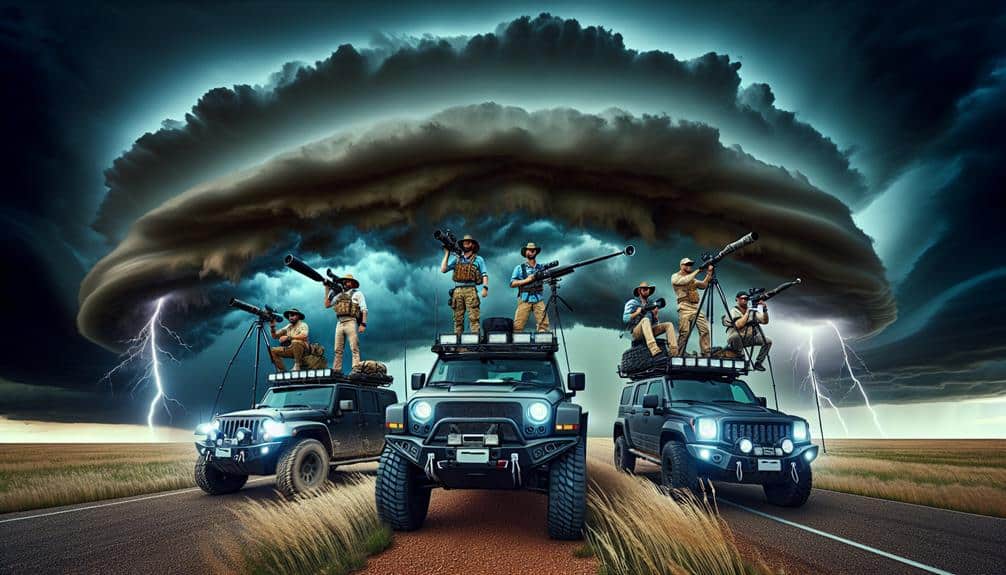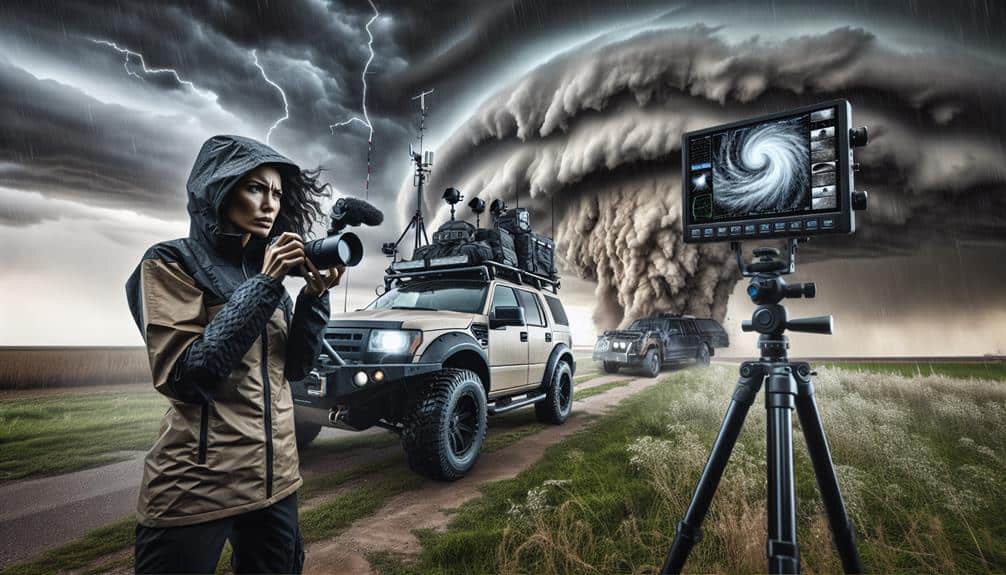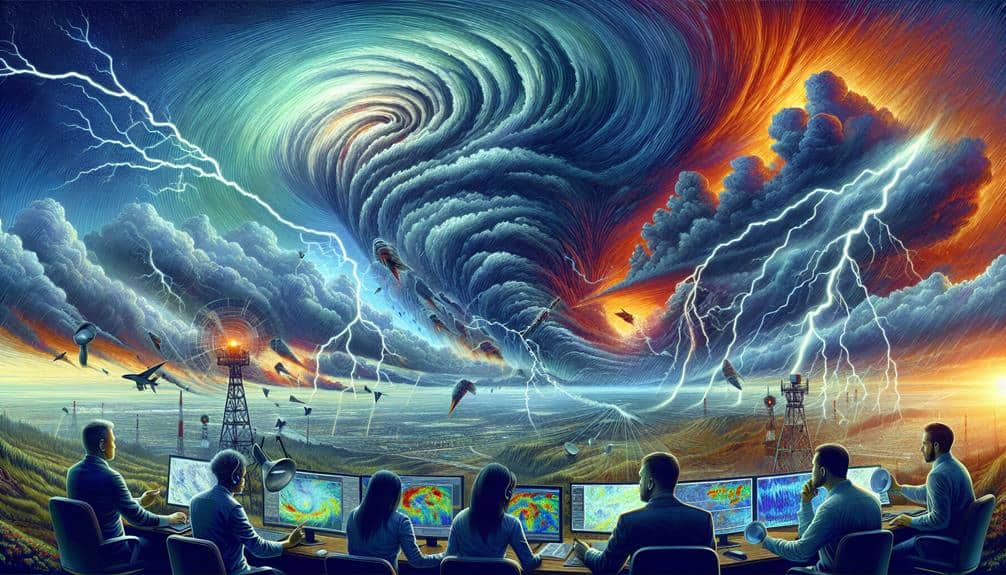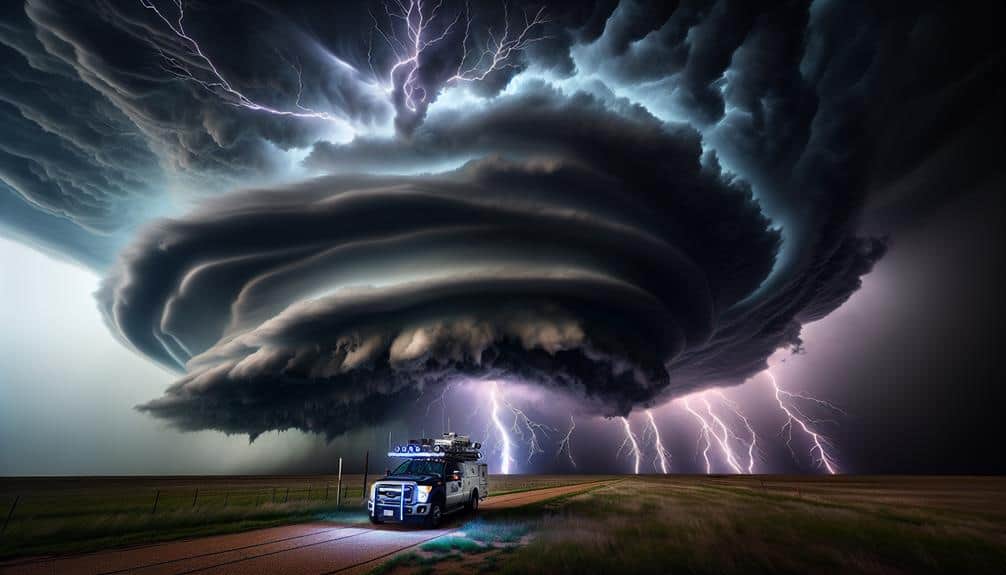We chase supercell storms in Tornado Alley for a blend of scientific pursuit and the thrill of extreme weather. Analyzing tornado dynamics in this region, which sees 1,200 tornadoes annually, advances our meteorological research and public safety measures. Tools like Doppler radar and drones enhance our storm prediction capabilities. Capturing dramatic visuals not only provides valuable data but also boosts community preparedness. The adrenaline rush and camaraderie among chasers heighten our senses and enrich our experiences. With every chase, our understanding deepens and our contributions to meteorological science grow. There's much more to uncover about this captivating endeavor.
Key Points
- Supercell storms in Tornado Alley offer thrilling and unique opportunities for viewing and documenting extreme weather.
- Storm chasers collect valuable meteorological data, improving tornado prediction models and public safety measures.
- Capturing dramatic footage of storms aids in enhancing public awareness and preparedness for severe weather events.
- Chasing storms provides an adrenaline rush and a sense of accomplishment through exploration and documentation.
Fascination With Extreme Weather
Many of us are captivated by extreme weather due to its unpredictable nature and the sheer power it exhibits. For weather enthusiasts and adrenaline junkies alike, supercell storms in Tornado Alley offer a unique and thrilling opportunity.
The National Weather Service reports that Tornado Alley experiences more than 1,200 tornadoes annually, making it a hotspot for thrill-seeking and danger-loving individuals.
We're driven by the sheer exhilaration of witnessing nature at its most formidable. Supercell storms, characterized by their rotating updrafts, are particularly enticing due to their potential to spawn tornadoes. According to the Storm Prediction Center, about 20% of supercell storms produce tornadoes, adding a layer of unpredictability and excitement to our pursuits.
We analyze weather models, radar data, and atmospheric conditions to predict when and where these storms will occur. This precise, data-driven approach allows us to maximize our chances of encountering these natural phenomena safely.
The freedom to chase and document these storms offers an unparalleled sense of adventure and achievement. For us, the fusion of scientific curiosity and the desire for adrenaline makes storm chasing an irresistible endeavor, blending the thrill of the chase with the pursuit of knowledge.
Understanding Tornado Formation
To understand tornado formation, we must analyze the intricate interplay of atmospheric conditions that give rise to these powerful phenomena. Tornado dynamics involve a precise sequence where warm, moist air collides with cold, dry air, creating a volatile environment. This collision often occurs in Tornado Alley, a region known for its unique topographical and meteorological setup.
First, we need a supercell thunderstorm, characterized by a rotating updraft known as a mesocyclone. When wind speeds and directions change with altitude—a phenomenon called wind shear—it tilts the rotating updraft into a vertical orientation. This vertical tilt is essential for sustaining the storm's rotation and longevity.
Next, the mesocyclone tightens and accelerates, much like a figure skater pulling in their arms to spin faster. This process intensifies the rotation near the ground, often leading to the formation of a tornado. The convergence of rising warm air and descending cool air creates a low-pressure zone that can cause the funnel to touch down.
Advancing Meteorological Research
We're leveraging unprecedented data collection opportunities to enhance our understanding of supercell storms.
By integrating this data into advanced prediction models, we can enhance our ability to forecast tornadoes.
These advancements aim to increase both accuracy and lead time, which are essential for public safety.
Data Collection Opportunities
Leveraging advanced technology, we gather essential data from supercell storms to refine predictive models and enhance meteorological research. Our efforts in Tornado Alley allow us to push the boundaries of research potential and exploit technological advancements. By collecting high-resolution data directly from these storms, we aim to improve forecasting accuracy and provide better risk assessment for affected communities.
Our data collection strategy involves:
- Doppler Radar Systems: These systems offer real-time data on storm velocity and intensity, helping us understand storm dynamics.
- Mobile Mesonets: Equipped with sensors, these mobile units measure temperature, humidity, and wind speed at ground level, providing granular data.
- Drones: Drones capture aerial data and offer a unique perspective on storm structure, which is essential for in-depth analysis.
- Storm-Tracking Software: Advanced algorithms in these software systems process vast amounts of data, identifying patterns and anomalies that enhance our research.
Improving Prediction Models
By integrating high-resolution data from Doppler radar, mobile mesonets, drones, and storm-tracking software, we enhance the accuracy of supercell storm prediction models to a great extent. These technological advancements allow us to collect detailed, real-time data, which feeds directly into our forecasting techniques. With this influx of precise data, we can refine the algorithms and parameters that drive our predictive models, leading to better model accuracy.
The use of mobile mesonets and drones provides on-the-ground and aerial perspectives that traditional radar systems can't capture. This multi-dimensional data helps us understand the microphysics of supercell storms, such as wind shear, updrafts, and downdrafts, in unprecedented detail. Consequently, our forecasting techniques become more robust, enabling us to predict storm behavior with higher confidence.
Moreover, storm-tracking software aggregates and analyzes this data in real-time, allowing for dynamic updates to prediction models. This iterative process means that our models are constantly evolving and improving.
Capturing Dramatic Footage
Capturing dramatic footage of supercell storms requires precise timing, advanced equipment, and an understanding of meteorological patterns. We chase these intense storms to document their raw power and create dramatic visuals that captivate audiences. Achieving exceptional footage involves several critical steps:
- Timing: We must predict the storm's development and position ourselves in the best location. Missing the perfect moment means losing the most dramatic visuals.
- Equipment: High-definition cameras, drones, and specialized weather instruments are essential. They allow us to capture the storm's intensity and structure in outstanding detail.
- Meteorological Knowledge: Understanding weather patterns helps us anticipate storm behavior. This includes analyzing radar data, storm tracks, and atmospheric conditions.
- Safety Protocols: While capturing footage, we must adhere to safety guidelines to protect ourselves and our equipment.
Our goal is to document the sheer power and beauty of supercell storms. This quest for dramatic visuals also contributes valuable data to the meteorological community. By capturing these intense storms on film, we're not just satisfying our own curiosity but also providing educational and research material that can be used to better understand these formidable natural phenomena.
Enhancing Public Safety

Our footage of supercell storms not only showcases their dramatic power but also plays an important role in enhancing public safety by providing real-time data and visual evidence to meteorologists and emergency services. By capturing these storms, we contribute to a deeper understanding of their behavior, which directly supports public education efforts. Accurate, timely information allows meteorologists to issue more precise warnings, thereby increasing the lead time for communities to prepare and respond.
Data-driven analysis of our footage can indicate storm intensity, trajectory, and potential impact zones. This information is invaluable for emergency response teams who must make swift decisions about resource allocation and evacuation procedures. In fact, studies have shown that the real-time data we provide can improve the accuracy of tornado warnings by up to 60%. This, in turn, reduces casualties and property damage.
Moreover, sharing our footage with the public fosters a culture of awareness and preparedness. Educational campaigns often use our visual evidence to teach people about the signs of an approaching supercell storm and the steps they should take to stay safe. Ultimately, our efforts empower individuals and communities to respond more effectively to severe weather events.
Experiencing Adrenaline Rush
The thrill of chasing supercell storms stems from the unique combination of scientific curiosity and the sheer exhilaration of confronting nature's most powerful phenomena. We're drawn to these risky adventures by the adrenaline rush that comes from being so close to a force that can be both beautiful and deadly. Thrill seeking behavior is a significant factor that drives us into the heart of Tornado Alley.
Let's break down why this pursuit is so compelling:
- Adrenaline Response: Our bodies release adrenaline, heightening our senses and reactions, providing an unmatched feeling of being alive.
- Unpredictability: The chaotic nature of supercell storms means each chase is different, offering an element of surprise and challenge.
- Data Collection: The need to gather real-time data for predictive models adds a sense of purpose and urgency to our risky adventures.
- Personal Achievement: Successfully exploring and documenting a storm provides a sense of accomplishment and mastery over a formidable natural event.
Statistical analysis shows that chasing storms isn't just about the thrill—it's a blend of curiosity, scientific contribution, and the human desire for freedom and adventure. We find ourselves continually drawn back, driven by the rush and the quest for knowledge.
Community and Camaraderie

In the world of storm chasing, a strong sense of community and camaraderie emerges as we build relationships with fellow chasers who share our passion and commitment. This unique bond is indispensable, providing team support and shared excitement during each pursuit. Data indicates that collaborative efforts enhance the accuracy of storm predictions and safety measures. When we operate as a cohesive unit, we optimize our chances of capturing critical data and breathtaking footage.
Our shared passion for supercell storms in Tornado Alley often leads to lifelong friendships. These connections aren't just about the thrill; they're about mutual respect and understanding. We rely on each other for real-time information, strategic planning, and emotional support in high-stress conditions. According to a survey among veteran storm chasers, 87% attribute their most memorable experiences to the camaraderie built during these adventures.
We don't just chase storms; we chase the sense of freedom that comes with it, knowing we've a reliable network backing us. This collective spirit not only enhances our individual experiences but also contributes to the broader scientific community. Together, we're more than the sum of our parts, driven by a shared excitement and unwavering support.
Frequently Asked Questions
What Equipment Do Storm Chasers Typically Carry?
With 1,200 tornadoes annually, we carry camera gear, survival items, and communication devices. Our weather instruments include anemometers and barometers. Preparedness guarantees we document safely, maintaining our freedom to chase the storms we're passionate about.
How Do Storm Chasers Stay Safe During Severe Weather?
We prioritize safety precautions and emergency protocols by using advanced communication devices and precise weather tracking. By constantly monitoring conditions and staying connected, we guarantee our team's well-being while experiencing the freedom to study severe weather firsthand.
What Are the Legal Restrictions on Storm Chasing?
When storm chasing, we must consider permit requirements, safety protocols, and liability concerns. Insurance needs are essential to cover potential damages. While laws vary by state, adherence to rules guarantees both safety and freedom during our adventures.
How Do Storm Chasers Communicate With Each Other?
We use various communication methods like radios, mobile apps, and GPS to share real-time data. Emergency protocols guarantee we stay connected and informed, enabling us to make quick, coordinated decisions while maximizing our freedom and safety.
What Kind of Vehicles Are Best Suited for Storm Chasing?
We need vehicles tougher than tanks for storm chasing. Our storm chaser vehicles require modifications like reinforced windows and lifted suspensions. Essential storm chaser gear includes radar systems, GPS, and communication tools. Safety and mobility are paramount.


